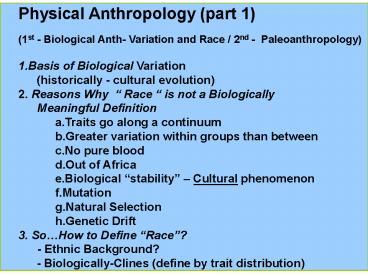Physical Anthropology part 1 - PowerPoint PPT Presentation
1 / 13
Title:
Physical Anthropology part 1
Description:
Natural Selection. Genetic Drift. 3. So...How to Define 'Race'? - Ethnic Background? ... 'Over the course of evolution, human ancestors became bigger and more ... – PowerPoint PPT presentation
Number of Views:120
Avg rating:3.0/5.0
Title: Physical Anthropology part 1
1
- Physical Anthropology (part 1)
- (1st - Biological Anth- Variation and Race / 2nd
- Paleoanthropology) - Basis of Biological Variation
- (historically - cultural evolution)
- 2. Reasons Why Race is not a Biologically
- Meaningful Definition
- Traits go along a continuum
- Greater variation within groups than between
- No pure blood
- Out of Africa
- Biological stability Cultural phenomenon
- Mutation
- Natural Selection
- Genetic Drift
- 3. SoHow to Define Race?
- - Ethnic Background?
- - Biologically-Clines (define by trait
distribution)
2
A sample topic of study in Biological Anth the
concept of Race
- How do scientists explain the spectrum of human
skin color around the globe? - Skin color
- -one of our most visible physical features
- -has been used to create human categories
- -human biological variation is much more
complex than this
3
Basis of beliefs about biological variation
- Historically cultural evolution
- The belief that biology was THE essential basis
for differences between types of people - social,
economic, etc. - So the more technologically advanced groups must
be biologically superior / more highly evolved
4
1. Traits go along a continuum
- We overlap
- . . . By about
- 85
5
Anthropologist Nina Jablonski, Ph.D. theorizes
that variations in human skin are adaptive traits
that correlate closely to geography and the suns
ultraviolet radiation, not race. "Over the
course of evolution, human ancestors became
bigger and more active as they moved into hot,
open environments in search of food and water. In
these places, one big challenge was keeping cool.
The adaptation that occurred was to . . .
6
. . . increase the number of sweat glands on
their skin while at the same time reducing the
amount of their body hair," explains Jablonski.
With less hair, perspiration could evaporate
more easily and cool the body more efficiently.
"But this less-hairy skin was a problem because
it was exposed to a very strong sun, especially
in lands near the equator." Strong sun exposure
damages the body. "The solution was to evolve
skin that was . . .
7
. . . permanently dark so as to protect against
the suns more damaging rays."
8
2. Greater variation within groups than between
groups
- Australian aboriginals
- A woman in India
9
3. No Pure Blood
- Mongoloid blood?
- German blood?
- Blue blood?
- Chartreuse?
10
4. Were all from the same place
- No
- Yes
11
5. Much of biological stability is
- cultural
12
Even with racial preservation, we wont remain
the same biologically
- 6. Mutation
- 7. Natural Selection
- 8. Genetic Drift
13
SoHow to Define Race?
- Ethnic Background?
- Biologically? One way Clines
- (define by trait distribution)
- (The point from Biological Anthropology Much
more complex than arbitrary social designations)































